
Invasive carps are already established in the Mississippi and Illinois Rivers, and are advancing toward the Great Lakes.

Everyone in Ontario, particularly those on the ‘front lines’ along the Great Lakes shorelines, should be on the lookout to prevent the introduction of invasive carps.

July 1, 2024 – Historic Agreement Signed to Keep Invasive Carp Out of the Great Lakes (Greatlakes.org) – Illinois, Michigan and the U.S. Army Corps of Engineers signed an agreement to begin construction on the Brandon Road Project to keep invasive carp out of the Great Lakes. The project has been in discussion since the early 2000s.
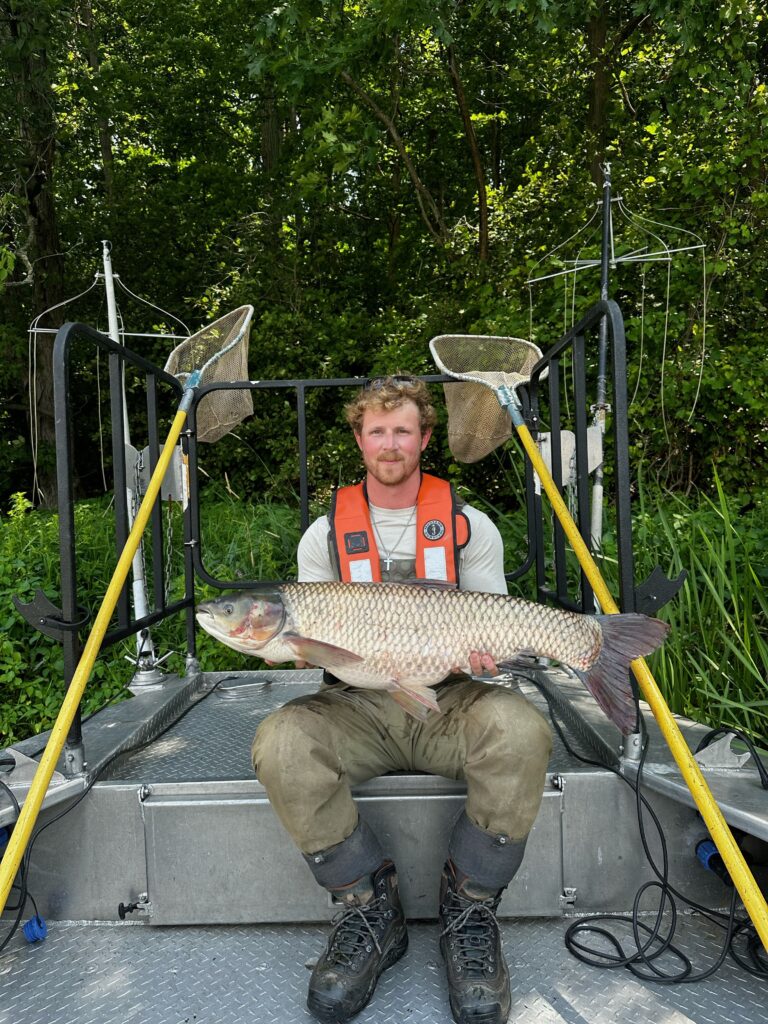
Earlier captures on the Great Lakes:
May 20, 2024 – a dead Grass Carp was collected by a member of the public in Rondeau Bay (Lake Erie). The fish was removed from the water and disposed of, prior to Fisheries & Oceans Canada (DFO) being alerted. No on-the-water operations are planned; however, DFO crews are keeping a close eye on the area, and are asking the public to, as well.
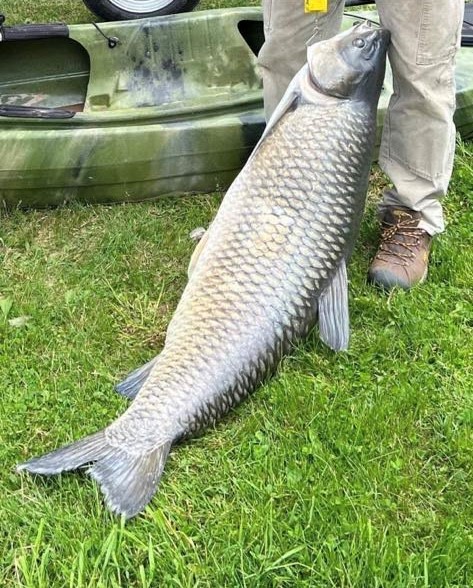
Altogether, there were 3 captures of Grass Carp in Canadian waters in 2023. Asian Carp Canada’s interactive map of Grass Carp Captures has been updated with the most recent capture information. View it here:
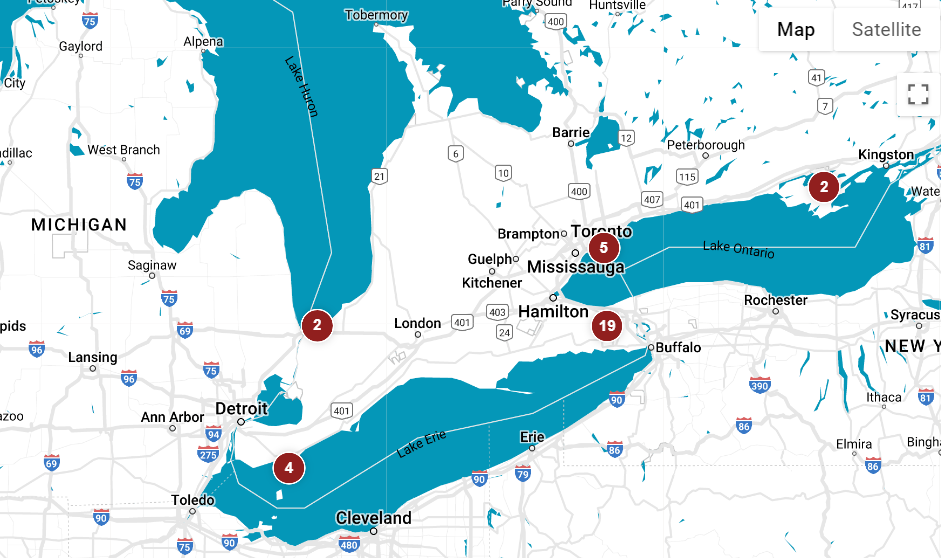
A Grass Carp was captured by a recreational angler in the Niagara River near Fort Erie, Ontario, on August 16, 2023. The Incident Command System responded. Lab testing found it to be sterile (unable to reproduce) so no further action was taken.
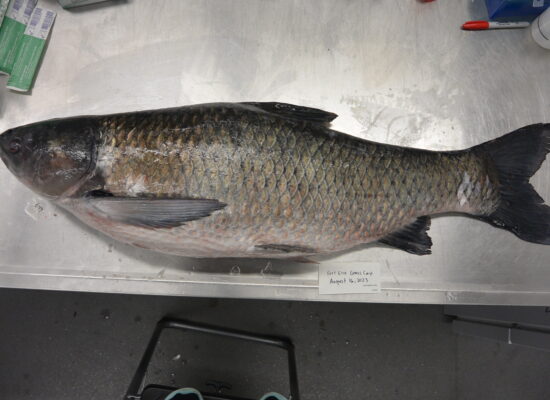

Would you be able to identify an invasive carp if you saw one?
Learn how to identify them below, and report sightings to www.eddmaps.org
or by calling the Invading Species Hotline at 1-800-563-7711.
There are four species known as invasive carps, as shown below (clockwise, from top left):
Black Carp, Bighead Carp, Grass Carp, and Silver Carp.
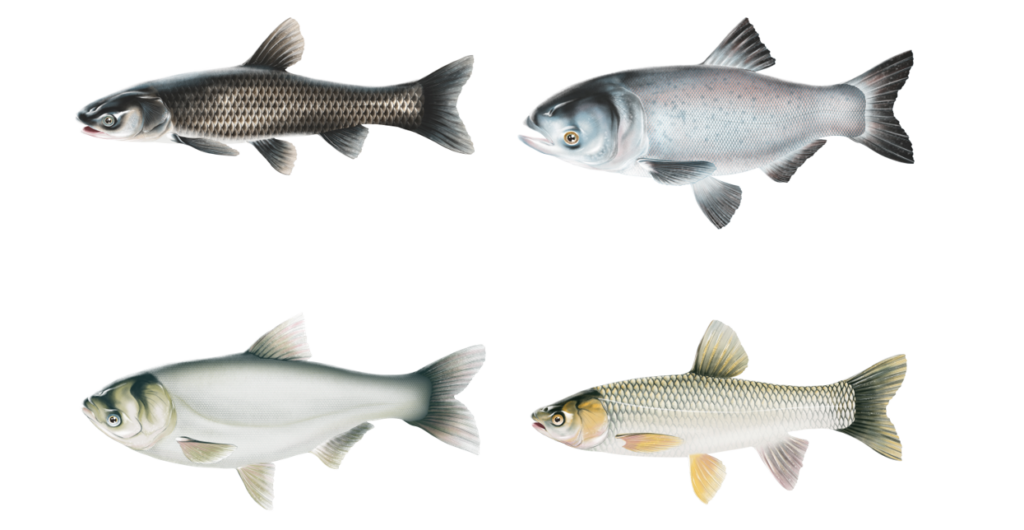
Download FOCA’s info sheet to help you identify invasive carps. (PDF, 2 pages)
All four species are voracious eaters! Bighead and Silver carps are avid voracious filter feeders, and can eat from 5 to 20% of their body weight in plankton per day. Plankton is the food that most aquatic species rely on; therefore, these carps have the potential to outcompete native fishes and other species. Silver Carp are slightly smaller than Bighead Carp but have been known to cause injury to boaters as they can jump up to 3 meters out of the water when disturbed.
Grass Carp can eat up to 40% of their body weight in aquatic vegetation per day! An established population can result in the loss of aquatic vegetation and eventually an overall decrease in water quality. This is because Grass Carp are often not able to digest all the vegetation they consume, so a lot of undigested vegetation ends up back in the water through Grass Carp excrement. This results in increased nutrient levels, which can lead to more frequent algal blooms, and eventually an increase in turbidity levels. The loss of vegetation can also lead to erosion of shorelines which contributes to poor water quality.
Adult Black Carp feed primarily on mollusks, such as mussels and snails, and use their pharyngeal teeth to crush the shells. They also eat freshwater shrimp, crawfish, and insects. Black Carp will compete for food with native species. Black Carp can also negatively impact native fishes, turtles, birds, raccoons, otters, and muskrats, through competition for food.
> Need more help identifying invasive carps, compared to established fish species including baitfish? Visit Confused with Carp from Asian Carp Canada for ID tips.
More Resources:
FOCA Webinar: Protecting our Great Lakes from Invasive Carps (September 2021) FOCA and our partners at Fisheries and Oceans Canada delivered a webinar to help you learn about the threat, and how to identify these carps and report sightings. (video, 1 hour) Download a copy of the slides. (PDF, 16 MB)
See jumping Silver Carp as well as Grass Carp in this short video featuring FOCA’s former Executive Director, Terry Rees:
Perspectives on Invasive Carp Prevention in Canada: Cottager
(video by Fisheries and Oceans Canada, 2021)
Download Fisheries and Oceans Canada’s Grass Carp ID sheet (PDF, 2 pages) to learn more about common “look a likes”.
Find out more about the impacts Grass Carp could have on water quality in these research documents: Ecological Risk Assessment of Grass Carp and the Biological Synopsis of Grass Carp.
Do you still have a question about invasive carps? Check out some frequently asked questions at the link below:
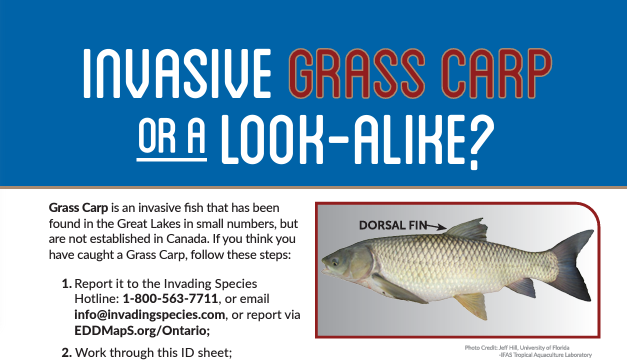

Please note: the following is archival material, and some links to third-party resources may no longer be active.
How did they get here?
Invasive carps were imported into North America in the 1960s and 1970s to be used in southern United States aquaculture operations. Flooding and intentional release allowed these fishes to escape in to the Mississippi and Illinois rivers in the early 1990s, and they have been advancing towards the Great Lakes ever since.
What is being done to protect the Great Lakes?
Almost a decade ago, the U.S. Army Corps of Engineers, the U.S. EPA, the State of Illinois, the International Joint Commission, the Great Lakes Fishery Commission, and the U.S. Fish and Wildlife Service began working together to erect and maintain an underwater electric barrier between established populations of carps and Lake Michigan. There are now 3 electric barriers in the Chicago Area Waterways System to assist in protecting Lake Michigan from the introduction of Asian carps. There has also been a 1,500 foot fish barrier fence installed at Eagle Marsh, near Fort Wayne, Indiana, to block advancement of invasive carps into Lake Erie.
The U.S. Army Corps completed DNA monitoring to identify the location of Asian carps in the Chicago canal and found that they are as close as one mile from the barrier.
The Great Lakes St Lawrence Cities Initiative and the Great Lakes Commission have raised funds to go ahead with their own study to come up with a plan to determine how to re-establish the natural separation between Lake Michigan and the Mississippi basin.
Since 2012, Fisheries and Oceans Canada (DFO) has been actively working to prevent the introduction and establishment of Grass, Bighead, Silver and Black carps in the Great Lakes. DFO is engaged in monitoring and surveilling Canadian waters near the most likely arrival points for signs of Asian carps, using techniques such as environmental DNA sampling, netting and electro-fishing. Between May and November, DFO crews visit up to 37 locations in lakes Erie, Huron, Ontario and Superior to conduct early detection surveillance sampling. These locations were selected based on predictive models which indicated that they have suitable habitats for invasive carps. Any invasive carps that detected are removed from the water and taken to DFO’s lab for further analysis.
What risk do invasive carps pose to Ontario Lakes?
If invasive carps are able to enter the Great Lakes and establish, they will have detrimental effects on commercial and sport fishing industries, recreational boating, and tourism across Ontario. They consume an enormous amount of food that other aquatic species rely on, therefore displacing native fishes and other species.
What is the status of these species in Canadian waters ?
Grass Carp currently represents the most immediate threat to Canadian waters. There have been no captures or recorded sightings of Silver Carp, Bighead Carp or Black Carp in Canadian waters since DFO’s Asian Carp Program began in 2012. However, very low numbers of Grass Carp have been captured in Canadian waters of Lakes Erie, Ontario and Huron, and even though there is confirmed spawning on the U.S. side of Lake Erie, there is no evidence Grass Carp are spawning, or are established in Canadian waters.
What you can do to prevent spreading these invaders:
One of the most effective ways for members of the public to assist in this vital effort is simply to share this information with your friends, family and colleagues. The more people who appreciate the costs and dangers posed by this potential invasion, the more motivated people will be to take an active part in defending Canadian waterways from the threat.
If you are a boater or a fisher: make sure your activities never offer a free ride to an invasive plant, fish or animal via your boat bilge or your bait buckets. Many public docks offer information to boaters and other travelers about invasive species and specific local concerns, but every individual must be vigilant.
If you are a lake association representative on the “front lines” (i.e., along the Great Lakes shorelines): consider posting signs at public boat launches warning of the dangers of transporting invasive species, and share this article in your next newsletter or e-news, or at local marinas on a notice board.
If you or anyone you know trades in live fishes: either for food, for pets or in aquaculture (pond) management, make sure you and they observe all regulations governing prohibited species and ask for expert help if there is any question about the identity of a particular fish.
If you think you have found an aquatic invasive species:
- Do not return it to the water.
- Take photos.
- Note the exact location (GPS coordinates), the observation date and identifying features
- Report it immediately by phone, using the Ontario Federation of Anglers and Hunters’ Invading Species Hotline at 1-800-563-7711, or online through the EDDMapS web-based mapping system: eddmaps.org
Other Resources and Partner Information:
Asian Carp Canada: https://www.asiancarp.ca/
Fisheries and Oceans Canada: http://www.dfo-mpo.gc.ca/species-especes/profiles-profils/asiancarp-carpeasiatique-eng.html
Ontario’s Invading Species Awareness Program: http://www.invadingspecies.com/asian-carps/
Invasive Species Centre: https://www.invasivespeciescentre.ca/invasive-species/meet-the-species/fish-and-invertebrates/asian-carps/
Ministry of the Environment Conservation and Parks: https://www.ontario.ca/page/asian-carps
Read the Invasive Carp Regional Coordinating Committee’s 2021 Asian Carp Action Plan (download PDF, 170 pages) This extensive document contains a portfolio of high-priority prevention, detection, and control projects developed to support a comprehensive science-based Asian carps management strategy.
As reported by the U.S. National Wildlife Federation in 2021, a recent study published by the North American Journal of Fisheries Management models the impacts that Asian carps could have on the food webs of the Great Lakes. Computer modelling predicts impacts of Bighead Carp on Lake Erie, in particular. Read more online here. (the graph at the side is part of Supporting Information document #3 on the American Fisheries Society posting)

Please note: the following is archival material, and some links to third-party resources may no longer be active.
Video: Protecting the Great Lakes from Asian Carps (Fisheries and Oceans Canada, 2019)
FOCA’s past Executive Director was one of the partners featured in this 2019 video on the subject of Asian carps and what is being done to prevent their establishment in the Great Lakes.
Feb. 28, 2024 – ‘Immediate threat to Canadian waters’: Here’s what the Invasive Species Centre wants you to know about grass carp (CTV News Ottawa)
Sept. 9, 2021: FOCA is quoted in the article, Lakegoers urged to keep an eye out for Asian carps (MyBancroftNow.com)
Summer 2020: The wetland habitat and aquatic vegetation that native species like Yellow Perch rely on for survival is at risk. A study by Gertzen et al. (2017) discussed how Great Lakes populations of Yellow Perch would be negatively impacted by the establishment of Grass Carp.
February 2020: Kentucky Fish and Wildlife trying new method of harvesting Asian carp (WPSD Local 6)
January 2020: US government funding project to prevent grass carp from gaining ground in lakes/Lake Erie (Manitoulin Expositor)
2019: Everything you need to know about the threat of grass carp (Rebecca Schroeder, Invasive Species Centre)
2019: 2019 Asian Carp Action Plan (Asian Carp Regional Coordinating Committee)
May 2018 – Why Asian carp pose a threat to the Great Lakes (Ohio News-Herald)
February 2018 – Asian Carp Exhibit now open at the Toronto Zoo
October 2, 2017 – genetic tests confirm Grass carp eggs found in the Maumee River, along the U.S. side of western Lake Erie (US Asian Carp response group)
January 30, 2017 – New analysis says it is “very likely” that Grass Carp will become established in Lakes Erie, Huron, Michigan and Ontario within 10 years unless effective steps are taken to stop them: Grass carp have invaded Lakes Erie, Michigan and Ontario: Study (Windsor Star)
January 12, 2017 – The Asian Carp Regional Coordinating Committee’s (ACRCC) announced the release of its Fiscal Year 2017 Action Plan: Water Canada
October 3, 2016 – Great Lakes Fishery Commission and Fisheries and Oceans Canada Host Public Forum on Threat of Asian Carp
August 30, 2016 – Asian Carp caught near Point Pelee found in Lake Erie was fertile: MNRF (CTV Windsor)
July 15, 2016 – Officials say Common Carp often mistaken for invasive Asian carp: Sarnia Observer
June 4, 2016 – Asian carp caught for the first time in St. Lawrence River: CBC News
January 26, 2016 – Sound could be the answer to keeping invasive Silver Carp out of the Great Lakes. A recent study found that it’s a certain kind of sound that could be the key to scaring off unwanted fish. Find out more and listen to a sample of one of the sound files researchers used here.
Jan. 14, 2016 – Conservation experts are worried about the destructive impact Asian carp are likely to have on the Great Lakes ecosystem: Corporate Knights
January 2015 – Asian carps remain a risk to the Great Lakes. View the links below to learn about recent developments:
- Jan 23. – Despite DNA evidence, no Asian carp in Chicago River, says Illinois Department of Natural Resources
- OFAH holds Asian carp info sessions in early February
- Silver carp eDNA found above barrier
- Latest eDNA testing results from the Chicago region (U.S. Fish & Wildlife Service)
- New U.S. bill introduced to protect Great Lakes from Asian carp
- New Asian Carp Canada website
Jan. 4, 2016 – Asian carps could cause some Lake Erie fish to decline, others to increase: University of Michigan
Dec. 17, 2015 – View past webinars about Asian carps offered by the Invasive Species Centre: Webinar Series
Nov. 18, 2015 – Both juvenile and adult Silver and Bighead carps are disoriented by CO2, new research shows: UPI News Story
Nov. 9, 2015 – Asian carp caught in Lake Ontario weren’t born locally: CTV News Story
Sept. 29, 2015 – Meet Canada’s Asian carps detective: Toronto Star News Story
Sept. 18, 2015 – Asian carps caught near Point Pelee: CBC News Story
July 29, 2015 – Two live Grass Carp, considered highly invasive, found in Toronto pond: CBC News story
2014 – The invasive Asian carps are now closer than ever to the last barrier of defence between the infested Mississippi and Illinois Rivers and the Great Lakes. A series of three electric barriers on the Chicago Sanitary and Ship Canal is all that keeps the Asian carps out of the Great Lakes and it is feared that a heavy rain could flood the Des Plaines River, allowing the carps to breach the barrier. Environmental and conservation groups have been urging the Illinois and Obama administration to take action by closing the shipping locks. This has set into motion a study, by the U.S. Army Corps of Engineers, to be completed over the next 4 years. The Chicago barge and tour boat companies argue that closing the locks would have detrimental effects on their businesses.
Nov 2013 – In October 2013, the U.S. Geological Survey confirmed the first evidence that grass carp are naturally reproducing in the Great Lakes, specifically in the Sandusky River, Ohio, a tributary of Lake Erie.
July 24, 2013– (U.S.) Feds update plan to protect Great Lakes from carp – $50 million investment announced today (Associated Press)
July 2013 – New Report Tipping the Scales: How Canada and Ontario can prevent an Asian carp invasion of the Great Lakes.
Nov. 2012 – Terry Rees of FOCA joined a capacity crowd of key players from the U.S. and Canada at the Asian Carp Public Forum to discuss Asian carp control strategies, the extent of the issue, and what individuals can do to stop the introduction of Asian carp to the Great Lakes, and beyond.
For more about other invasive species that threaten Ontario’s lands, lakes and rivers, visit FOCA’s Invasive Species webpage.
